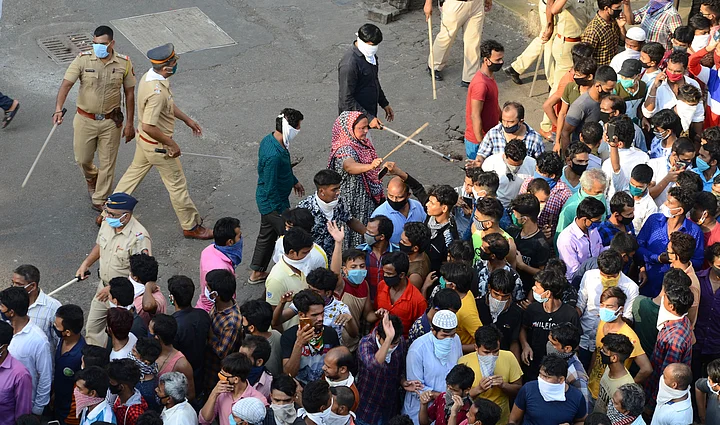Much brouhaha preceded the Prime Minister’s address to the nation on April 14 regarding extension of the 21-day lockdown. Lockdown extension became a matter of fierce debate, with foreseeable COVID-19 ravages pitted against widespread destitution and unemployment. There is merit in reflecting back on the purpose of the 21-day lockdown, and the extent of its fruition. The same shall help understand the need for any extension and the responses it should comprise. We shall then return to the government’s decision of extending the lockdown, albeit in a graded manner.
India entered a 21-day lockdown on March 25th with nearly 600 confirmed cases across 26 states/UTs. The rationale offered was that the three-week period had epidemiological significance based on the maximum incubation period of SARS-CoV-2 (14 days), and would see tailing of infection. The inherent assumption in conceiving this ideal situation was that any COVID-19 cases during the period would be contained from spreading infection, and that we would emerge with a ‘flattening of the curve’.
To achieve this, it was imperative to chase and check emergent cases through such measures as contact tracing, testing, and isolation – not just widely but also speedily – with stringent social distancing as the pre-condition.
We didn’t have the luxury of a Wuhan-style lockdown – and even in Wuhan, nearly 1800 epidemiologist teams were deployed for rigorous contact tracing. The key was to act early, so as to be able to finish early. Our purpose should therefore have reflected in building a robust armamentarium comprised of field-level workers and testing capacity beforehand. As this author has argued, facilitative measures for ‘flattening the curve’ like compulsory mask usage warranted early introduction. Strong capacities and policies in none of the above areas existed as we entered the lockdown – belying our stated purpose behind instituting it. The lockdown had little power over those already infected but not yet diseased. Soon, the Tablighi Jamaat fiasco and migrants’ exodus became burning themes and contributed to a surge of cases. Testing was slow to pick up, and only on April 9th was the testing strategy revised to make somewhat liberal allowances for hotspots and migration gatherings. On April 10th, rapid testing kits were still to be realised, as cited by the health minister himself.
Given the above – the number ‘21’ became arbitrary. This was evident when even on April 11, we saw a clear spike of 1035 new cases, indicating active spread of infection stretching into the first few days of April (note the time lag). This is while certain states continue to lag behind in testing. Any decision of substantially withdrawing restrictions is only warranted when you have moved well past the peak of infection. Lockdown extension was thus a no-brainer.
Bolstering Healthcare and Raising the Bar
Let’s consider the second stated purpose of the lockdown – to buy time for bolstering the healthcare machinery to deal with a possible deluge of COVID-19 post lockdown. We lacked in nimbleness here too. Concerns about abject shortage of personal protective equipment (PPE) peaked in March end-early April, well into the lockdown, and still continue. Extra workforce was roped in but is still insufficient in numbers, and requires greater differentiation. A volunteering call for AYUSH doctors and an advisory of human resource management were released in early April.
Makeshift isolation and treatment arrangements have been commendably conceived, but are still in no position to tackle the ravages of COVID-19 let loose without sizeable restrictions. Again, ‘21’ lost its significance and lockdown extension became a no-brainer.
Other reasons offered for the 21-day lockdown, such as spreading public awareness, make a weak case for discussion. The lockdown was largely unavoidable for us back then, given the viral rampage that was forecast. It was timely, and in terms of slowing the growth of COVID-19, has been reportedly quite successful. However, any examination of its success needs to be made in the context of what more could reasonably have been done. This is because of the great opportunity cost involved – that of compromising lives through restricting livelihoods. Our deficiencies in the above respects deterred us from making use of its full potential, squandering a big portion of the opportunity that the lockdown was.
Kerala has demonstrated how a lockdown could be optimally utilised, with its impressive before-after stats.
It is in this context that the extension of the lockdown by another 19 days needs to be examined. ‘19’ could easily be on course to becoming another arbitrary number like ‘21’. There is a critical need for acting early and heavily. A colossal marshalling of resources and initiative to check the spread of infection, right from the very beginning of the extended period, is warranted. Otherwise, another spike of cases at the end of the extended lockdown, and thus another extension with strict restrictions, will be inevitable. The Prime Minister underscored the criticality of intense monitoring of districts till the 20th of April. However, the same time frame will be even more crucial with respect to implementation of control activities. The demands remain largely similar: stringently enforced social distancing, ramped up testing, and isolation – with a focus on hotspots. This is in addition to pulling out all the stops to strengthen our healthcare infrastructure, supplies, and manpower.
Enforcing a lockdown is perceived as subtly disregarding the concerns surrounding the poor and their livelihoods. Even a graded lockdown with patchy yet stringent restrictions can limit economic activity and diffusion of gains significantly enough to allow little respite for the poor. We need to realise that full utilization of the lockdown period is one way of doing some justice to them.
(Soham D. Bhaduri is Editor, The Indian Practitioner, a healthcare commentator and columnist, and a medical doctor based in Mumbai.)
(At The Quint, we question everything. Play an active role in shaping our journalism by becoming a member today.)
